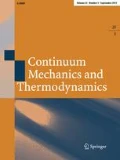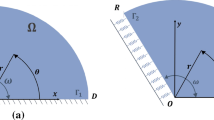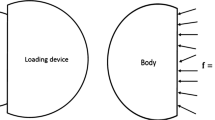Abstract
We consider a classical derivation of a continuum theory, based on the fundamental balance laws of mass and momenta, for a body with internal corner and surface contact interactions. The balances of mass and linear and angular momentum are applied to the arbitrary parts of a continuum which supports non-classical internal corner and surface contact interactions. The form of the specific corner contact interaction force measured per unit length of the corner is derived. A generalized form of Cauchy’s stress theorem is obtained, which shows that the surface traction on an oriented surface depends in a specific way on both the oriented unit normal as well as the curvature of the surface. An explicit form of the surface-couple traction which acts on every oriented surface is obtained. Two fields in the continuum, which are denoted as stress and hyperstress fields, are shown to exist, and their role in representing the surface traction and the surface-couple traction is identified. Finally, the field equations for this theory are determined, and a fundamental power theorem is derived. In the absence of internal corner and surface-couple traction interactions, the equations of classical continuum mechanics are recovered. There is no appeal to any ‘principle of virtual power’ in this work.
Similar content being viewed by others
References
dell’ Isola F., Seppecher P.: Edge contact forces and quasi-balanced power. Meccanica 32, 33–52 (1997)
Fosdick R.: Observations concerning virtual power. Math. Mech. Solids 16, 573–585 (2011)
Fosdick R.: On the principle of virtual power for arbitrary parts of a body. Continuum Mech. Thermodyn. 23, 483–489 (2011). doi:10.1007/s00161-011-0191-z
Fosdick R.L., Epifanio G.V.: A variational proof of the stress theorem of Cauchy. Arch. Ration. Mech. Anal. 105, 95–103 (1989)
Germain P.: La méthode des puissances virtuelles en mécanique des milieux continus. Premiére partie: théorie du second gradient. J. Méc. 12, 235–274 (1973)
Germain P. : The method of virtual power in continuum mechanics. Part 2: Microstructure. SIAM J. Appl. Math. 25, 556–575 (1973)
Greer, J.R.: See the website http://jrgreer.caltech.edu/research.php#projects for discussion and illustrations
Maugin G.: The principle of virtual power: from eliminating metaphysical forces to providing an efficient modelling tool. Continuum Mech. Thermodyn. 25, 127–146 (2013)
Noll W., Virga E.G.: On edge interactions and surface tension. Arch. Ration. Mech. Anal. 111(1), 1–31 (1990)
Podio-Guidugli P., Maurizio V.: Hypertractions and hyperstresses convey the same mechanical information. Continuum Mech. Thermodyn. 22, 163–176 (2010)
Author information
Authors and Affiliations
Corresponding author
Additional information
Communicated by Victor Eremeyev, Peter Schiavone and Francesco dell'Isola.
To David Steigmann in recognition of the depth and breadth of his research contributions and his unwavering dedication to the advancement of fundamental continuum mechanics.
Rights and permissions
About this article
Cite this article
Fosdick, R. A generalized continuum theory with internal corner and surface contact interactions. Continuum Mech. Thermodyn. 28, 275–292 (2016). https://doi.org/10.1007/s00161-015-0423-8
Received:
Accepted:
Published:
Issue Date:
DOI: https://doi.org/10.1007/s00161-015-0423-8




